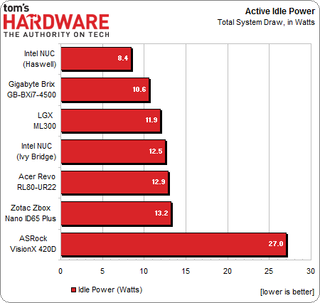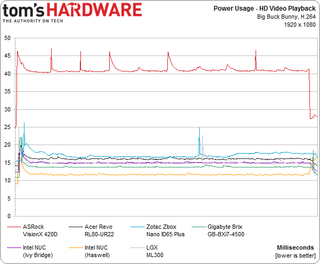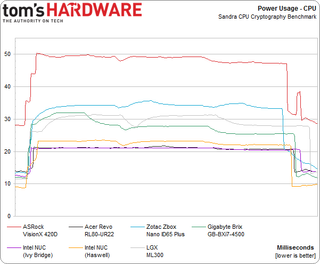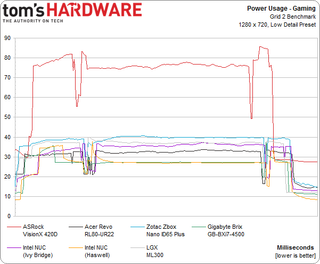Seven Small (But Powerful) Mini-PCs, Reviewed
Power Usage Benchmarks
Let's start with a power and temperature reading at idle, which should give us some idea of how these systems behave most of the time.

Every mini-PC except for ASRock's registers idle power consumption between 8.4 and 13.2 W. The VisionX is penalized for its add-on GPU, which pushes power use to 27 W at idle.

When we kick off a video playback workload, the VisionX continues pulling the most power as we measure 45 W. The other PCs sip between 12 and 17 W, which is barely above their idle consumption results.

Next, we tax each CPU with Sandra's Cryptography benchmark and record a wider range of results. ASRock's VisionX continues to use between 40 and 50 W, while the competition start around 20 and peak around 35 W. Turbo Boost and available thermal headroom most definitely play a role in how much these chips are allowed to ramp up.

A gaming workload shows us that ASRock's Radeon GPU requires a lot more power than Intel's built-in graphics engines. Of course, you do get all of that extra performance. And compared to most gaming desktops, a 95 W ceiling is still pretty reasonable. The other compact platforms hover between 25 and 40 W, albeit at sub-standard frame rates.
Current page: Power Usage Benchmarks
Prev Page Game Benchmarks: Medium Detail, 1080p Next Page Temperature BenchmarksStay on the Cutting Edge
Join the experts who read Tom's Hardware for the inside track on enthusiast PC tech news — and have for over 25 years. We'll send breaking news and in-depth reviews of CPUs, GPUs, AI, maker hardware and more straight to your inbox.
-
outlw6669 Not a single AMD based SFF PC?Reply
I am disappoint, this would be a great area for AMD to show their competitiveness. -
ta152h @outlw6669I built one based on the A6 5200, and it's perfect for what I need it for. It's low power, more than fast enough for what 99% of the people do, quiet, and inexpensive. I'm a little surprised they didn't choose something based on the Jaguar for that reason, but it might just be a situation where nothing with one was sent to them for review. Certainly this is a poor representation, without both Jaguar and Bay Trail missing. I got to the first page, read what they had, looked at the cases, and moved on. Reading about different versions of Ivy Bridge and Haswell and how they compare to each other is profoundly uninteresting.Reply -
m32 I wouldn't mind having a small system like this. Maybe Mid-Year when everyone's CPU/APUs are out, I'll have the chance to make a smart buy. Thanks for the article. :)Reply -
mesab66 It is interesting that by going slightly larger with the enclosure space (still keeping within cube/rectangle/media player shape) opens up the possibility of so much more power....dedicated gfx, full cpu, etc etc., and, can be cheaper to build - depending on the users requirements.......of course, at the cost of power requirements, etc. I'm thinking most folk would ideally chose a slightly larger form factor for living room/media pc duties.On the other hand, if constraints are tight (form factor in this article) and the end user's requirements match, then these options are worth considering.Reply -
s997863 Power. I don't care about no power. Where's the love for the old games? If I want to play some of the classics which just don't emulate properly, I have to hunt for a heavy old Pentium3 box and try to get it working. How about a cheap mini PC with miniaturized legacy hardware for full compatibility to dual-boot win98 & XP, with gameports, VGA & S-Video, PS/2 & USB, IDE & SATA external ribbon & power connectors, & a turbo button for choosing between 2 processors 200MHz & 3GHz?Reply -
vertexx I am a huge fan of compact systems. Almost everything I have built has been ITX. But I've had a hard time with the NUC form factor. As a desktop, I think it's actually too small. One of those boxes would get lost on my desk, continuously being pushed around by other clutter. Now, if I had a hutch with an optimally sized cubby, that might be a different story.Reply
VESA mounted on the back of a monitor, these look really clunky, and I'd rather go with an AIO kit using the thin mini-ITX form factor where I have more control over processor choice.
I'd be more excited if this technology and form factor were applied in a more interchangeable system with a standardized GPU socket. I really like what ASRock and Gigabyte have done with their compact systems. They're not as compact, but having something a little more substantial on my desk is a good thing, and they pack a lot of punch. I just wish the standards were developed to allow builders to replicate that feat - pipe dream, I know.
One thing is for sure, AMD needs to develop it's own equivalent of the NUC and thin Mini-ITX. The success of it's Kaveri line I think would be helped out by innovation in form factor. -
axehead15 I think you should compare the Mac Mini to these, that way we can see how it adds up.Reply
